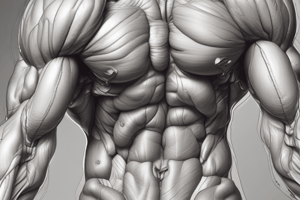Podcast
Questions and Answers
What are the three distinct types of muscle?
What are the three distinct types of muscle?
- Upper body, lower body, and core
- Skeletal, cardiac, and smooth (correct)
- Flexor, extensor, and pronator
- Biceps, triceps, and quadriceps
How many muscles are there approximately in an adult male human body?
How many muscles are there approximately in an adult male human body?
- 640 (correct)
- 500
- 320
- 1000
What is the basic building block of striated muscle tissue?
What is the basic building block of striated muscle tissue?
- Actin
- Sarcomere (correct)
- Myofibril
- Fibril
What controls the contraction of each muscle fiber?
What controls the contraction of each muscle fiber?
Which of the following is a cause of muscular dystrophy?
Which of the following is a cause of muscular dystrophy?
What is the approximate global prevalence of muscular dystrophy?
What is the approximate global prevalence of muscular dystrophy?
Which type of muscular dystrophy affects the patient's heart and lungs?
Which type of muscular dystrophy affects the patient's heart and lungs?
Which is one of the most common types of muscular dystrophy?
Which is one of the most common types of muscular dystrophy?
What is the primary function of myosin heads within the sarcomere?
What is the primary function of myosin heads within the sarcomere?
How do muscles continuously replace discharged ADP with ATP?
How do muscles continuously replace discharged ADP with ATP?
What is the role of calcium ions in sarcomere contraction?
What is the role of calcium ions in sarcomere contraction?
How are skeletal muscles organized for control?
How are skeletal muscles organized for control?
What is the function of tendons in relation to muscles?
What is the function of tendons in relation to muscles?
How is ATP production affected by exercise?
How is ATP production affected by exercise?
What is the primary difference between aerobic and anaerobic ATP production?
What is the primary difference between aerobic and anaerobic ATP production?
What regulates smooth muscle contraction?
What regulates smooth muscle contraction?
What is the point where a motor neuron attaches to a muscle to initiate muscle contraction?
What is the point where a motor neuron attaches to a muscle to initiate muscle contraction?
What is the primary source of ATP production at rest?
What is the primary source of ATP production at rest?
How are skeletal muscles distinct from cardiac and smooth muscles?
How are skeletal muscles distinct from cardiac and smooth muscles?
What is the primary function of myosin heads within the sarcomere?
What is the primary function of myosin heads within the sarcomere?
Flashcards are hidden until you start studying
Study Notes
Muscle Physiology and Function
- Within the sarcomere, actin and myosin fibers overlap, with myosin heads providing attachment points on binding sites for actin filaments.
- Myosin heads move in a coordinated style, swiveling toward the center of the sarcomere and detaching and reattaching to actin filaments in a ratchet-type drive system, consuming ATP.
- Muscles store little ATP, continuously replacing discharged ADP with ATP, and utilize creatine phosphate for rapid ADP regeneration.
- Calcium ions are essential for sarcomere contraction and are released from the sarcoplasmic reticulum when a muscle is stimulated to contract.
- The human body contains approximately 639 skeletal muscles, distinct from cardiac and smooth muscles in terms of structure and control.
- Smooth muscle contraction is regulated by the autonomic nervous system, hormones, and local chemical signals, allowing for gradual and sustained contractions.
- Neuromuscular junctions are the point where a motor neuron attaches to a muscle, releasing acetylcholine to initiate muscle contraction.
- Skeletal muscles are organized into motor units, each involving a motor neuron and controlling discrete bundles of muscle fibers.
- Tendons connect muscles to bones, enabling movement by transmitting muscle contractions to the skeleton.
- The body produces the majority of its ATP aerobically at rest, but during exercise, ATP production varies depending on intensity and duration.
- Aerobic ATP production is slower but produces no fatiguing waste products, while anaerobic production is faster but results in lactic acid buildup.
- Multiple diseases can affect the muscular system, impacting its function and overall health.
Studying That Suits You
Use AI to generate personalized quizzes and flashcards to suit your learning preferences.




